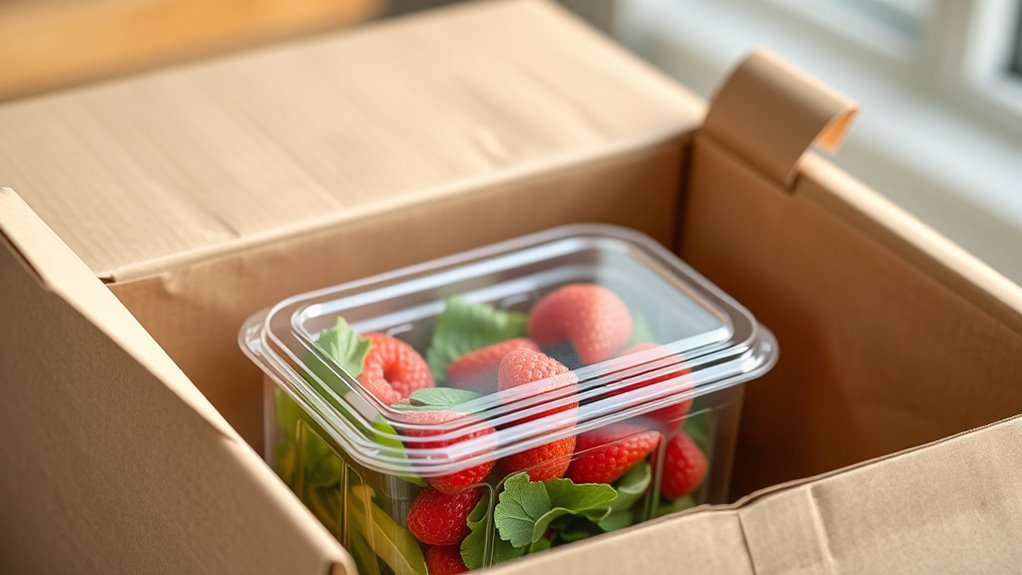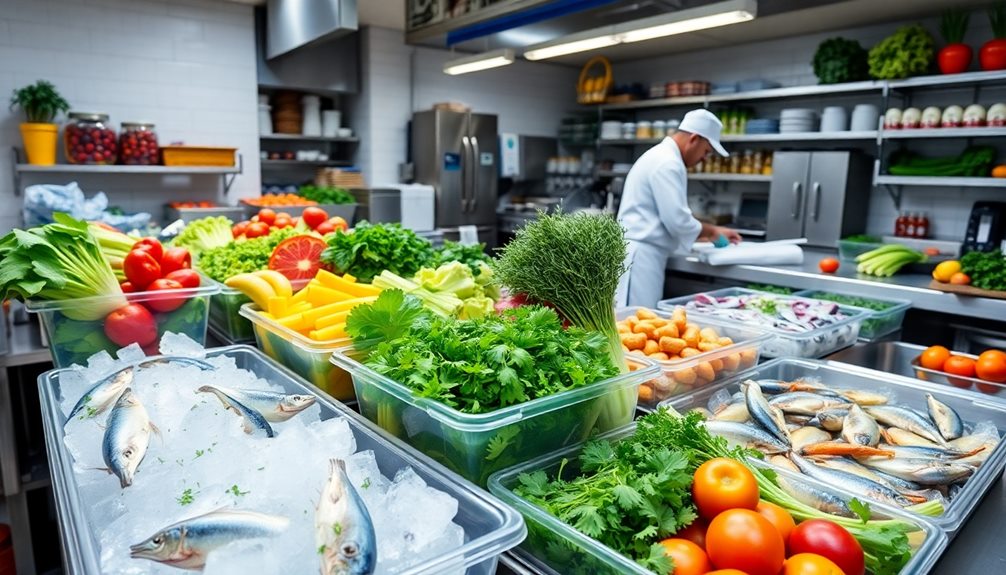To preserve quality during delivery, choose protective packaging that absorbs shocks and prevents damage. Use innovative insulation like phase change materials or reflective foils for temperature-sensitive items. Opt for custom-fit solutions to minimize movement and add tamper-evident features for security. Incorporate advanced sealing methods to maintain freshness, and select eco-friendly materials that don’t compromise protection. Exploring these strategies will ensure your products arrive perfect every time. Keep going to discover how to implement these techniques effectively.
Key Takeaways
- Use protective materials like bubble wrap and foam inserts to absorb shocks and prevent transit damage.
- Incorporate advanced insulation and phase change materials to maintain temperature-sensitive products during delivery.
- Employ custom-fit, tamper-evident packaging to secure items and prevent tampering or internal movement.
- Ensure proper sealing methods such as vacuum or heat sealing to keep products fresh and contamination-free.
- Implement rigorous quality control procedures, including inspection, monitoring transit conditions, and reliable carrier selection.
Importance of Protective Packaging Materials
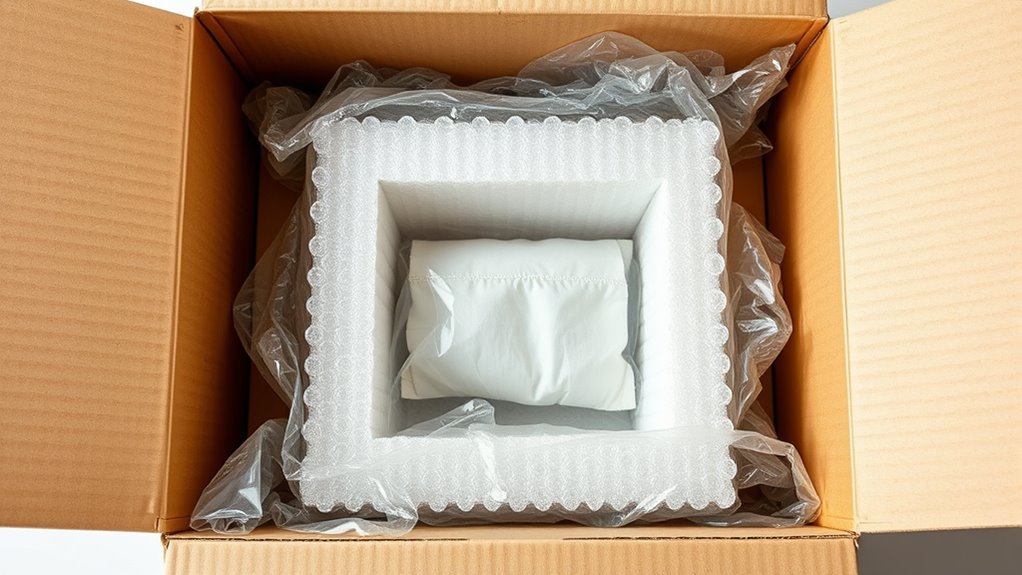
Protective packaging materials play a crucial role in ensuring your products arrive safely. They act as the first line of defense against damage during transit, handling, and storage. Using the right materials, like bubble wrap, foam inserts, or corrugated boxes, helps absorb shocks and prevent scratches, dents, or breakage. When you choose quality protective packaging, you reduce the risk of returns, refunds, and dissatisfied customers. Proper packaging also safeguards delicate or fragile items, maintaining their integrity and appearance. Additionally, selecting appropriate cushioning ensures that products are well-protected against impacts throughout the shipping process. It’s important to consider the nature of your product and select materials that offer adequate cushioning and support. Ultimately, investing in effective protective packaging not only preserves your product’s quality but also enhances your reputation for reliable delivery.
Innovative Insulation Techniques for Temperature-Sensitive Items
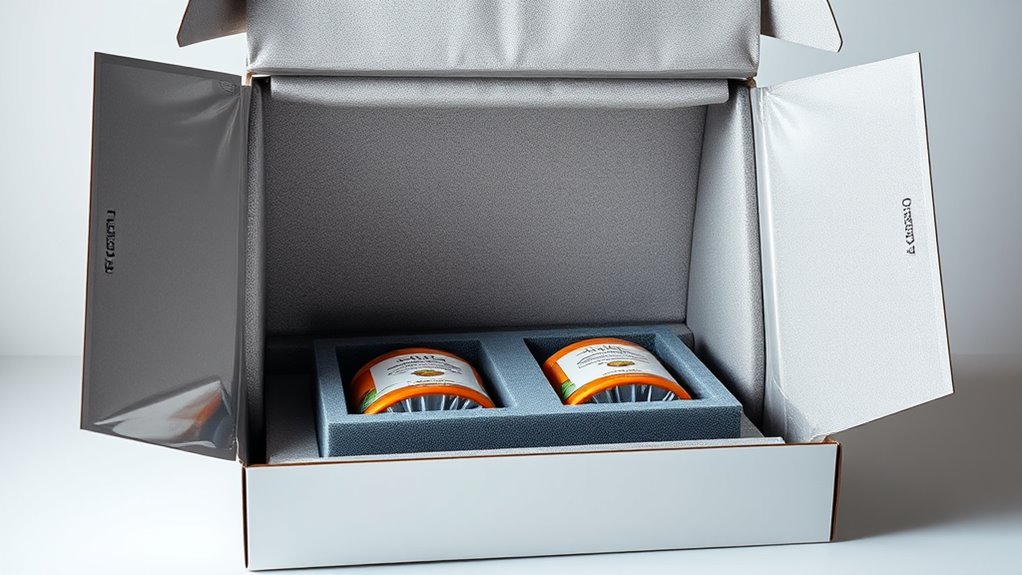
When shipping temperature-sensitive items, standard protective packaging may not be enough to maintain the right conditions. To improve insulation, innovative techniques are emerging that keep products at the ideal temperature longer. You can use phase change materials (PCMs) that absorb and release heat, maintaining a stable environment. Reflective foils bounce thermal energy away, preventing heat transfer. Insulating gels or foams adapt to temperature fluctuations, providing better protection. These advanced methods ensure your items stay within the desired temperature range during transit. Additionally, understanding celebrity lifestyle trends can offer insights into designing custom packaging solutions that appeal to high-end markets. By integrating these techniques, you reduce spoilage and guarantee quality upon delivery. Staying ahead with innovative insulation not only protects your products but also enhances customer satisfaction and trust.
Using Custom-Fit Packaging to Prevent Movement and Damage
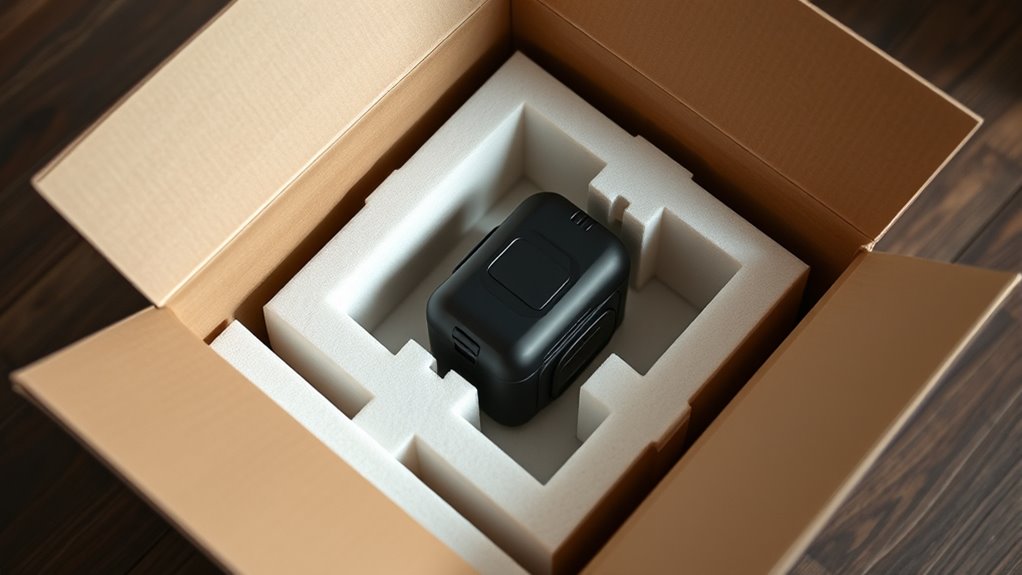
Using custom-fit packaging guarantees your items stay secure during transit, reducing the risk of damage. By choosing precise fit materials, you can prevent unnecessary movement inside the box. Secure packing techniques further reinforce protection, giving you confidence that your products arrive intact.
Precise Fit Materials
Custom-fit packaging materials are essential for ensuring your products stay secure during transit. When you select precise fit materials, you minimize movement inside the package, reducing the risk of damage. These tailored solutions conform exactly to your product’s shape, providing ideal protection. Using custom-fit foam inserts, molded pulp, or adjustable padding ensures your items remain stable throughout shipping. This targeted approach not only prevents breakage but also enhances your brand’s reputation for quality. Incorporating vertical storage solutions into your packaging process can further optimize space and efficiency during distribution.
Secure Packing Techniques
Secure packing techniques are essential for preventing movement and damage during transit. You should use custom-fit packaging that snugly holds your products in place, reducing the risk of shifting. Fill empty spaces with cushioning materials like foam or bubble wrap to absorb shocks and vibrations. Reinforce edges and corners with extra padding to protect vulnerable areas. Seal packages securely with strong tape, ensuring all openings are airtight. Label packages clearly with handling instructions, such as “Fragile” or “This Side Up,” to guide handlers. Consistent use of these techniques minimizes the chance of products being damaged en route. Additionally, incorporating vetted packaging materials ensures durability and optimal protection during shipping. By focusing on secure packing, you ensure your items arrive in perfect condition, preserving quality and boosting customer satisfaction. Proper packing is a crucial step in reliable delivery.
Eco-Friendly Packaging Options That Don’t Compromise Quality
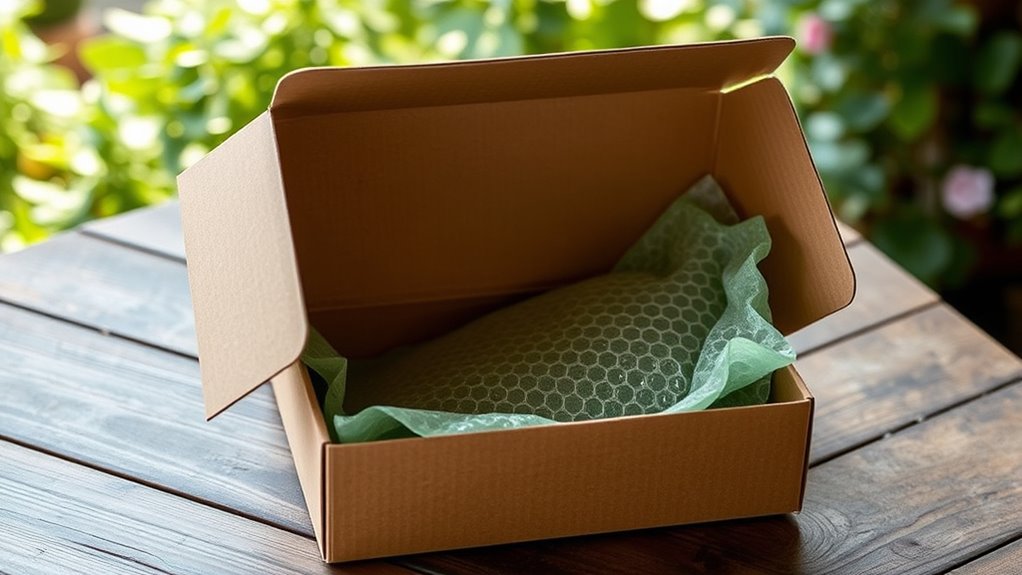
As consumers become more environmentally conscious, businesses are increasingly turning to eco-friendly packaging options that maintain high quality. You can choose sustainable materials that protect your products without sacrificing durability. For example, biodegradable plastics break down naturally, reducing waste. Recycled cardboard offers strength and eco-friendly benefits, making it perfect for shipping. Additionally, plant-based packaging materials, like mushroom or cornstarch-based containers, provide a compostable alternative that doesn’t compromise quality. When selecting eco-friendly options, guarantee they meet your product’s protection needs. Using these sustainable materials not only appeals to eco-minded customers but also supports your brand’s commitment to environmental responsibility. Incorporating packaging materials that align with environmental standards ensures your packaging remains both durable and eco-conscious. By choosing wisely, you deliver quality packaging that’s good for the planet and your reputation.
Incorporating Tamper-Evident Features for Security and Freshness
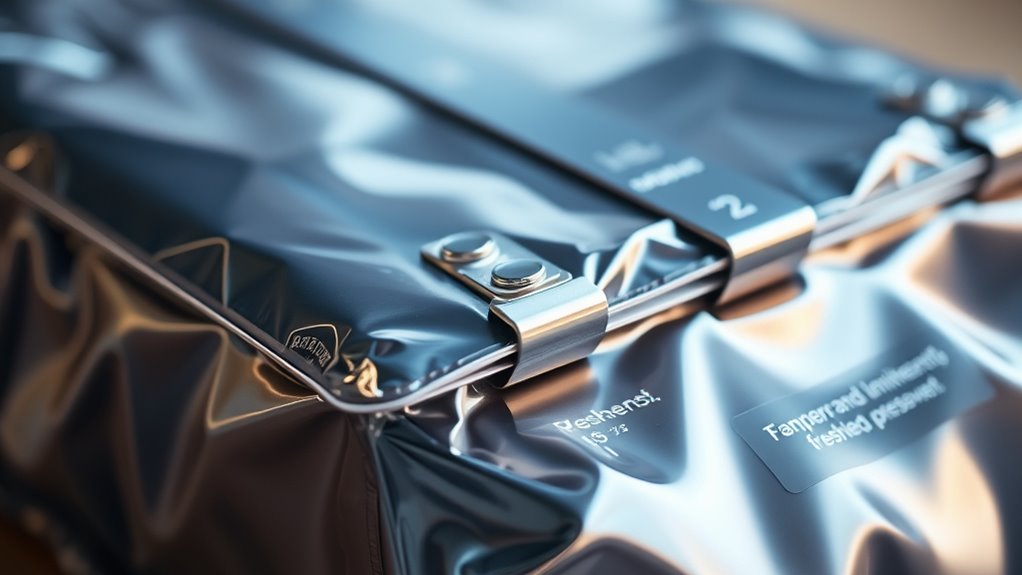
You want your packages to stay secure and fresh, so incorporating tamper-evident features is vital. Using effective detection techniques and reliable sealing methods helps guarantee your products arrive intact and safe. Proper packaging not only enhances security but also assures customers of product authenticity and freshness, much like verifying the authenticity of Care to Beauty products. Let’s explore how these strategies can boost security and preserve quality.
Tamper Detection Techniques
Tamper-evident features play a crucial role in ensuring the security and freshness of delivered packages. They help you quickly identify if a package has been opened or compromised before it reaches the customer. To enhance detection, consider using techniques like breakable seals that show visible signs of tampering, security tapes that leave a residue or change color when disturbed, and specialized packaging with holograms or unique markings. These methods make it obvious if someone has tried to access the contents, discouraging tampering and maintaining product integrity. Implementing these measures not only safeguards your products but also builds customer trust, assuring them that their delivery remains intact and secure during transit. Incorporating tamper-evident packaging features further enhances security by providing clear visual cues of unauthorized access.
Sealing Methods for Freshness
Sealing methods that incorporate tamper-evident features are essential for maintaining both the security and freshness of delivered products. You want to guarantee your items stay fresh from the moment they leave your facility until they reach the customer. Tamper-evident seals, like pull-tabs, breakable bands, or shrink wraps, provide visual proof if the package has been opened or tampered with. These seals not only prevent unauthorized access but also preserve the product’s quality by preventing air, moisture, or contaminants from entering. When selecting sealing methods, consider materials that create an airtight barrier and are easy for customers to identify as intact. Proper sealing reassures your customers, boosts confidence, and guarantees that your products arrive fresh and secure every time. Additionally, choosing vetted packaging options ensures safety and effectiveness, aligning with best practices for product preservation.
Advanced Sealing and Closure Methods to Maintain Freshness
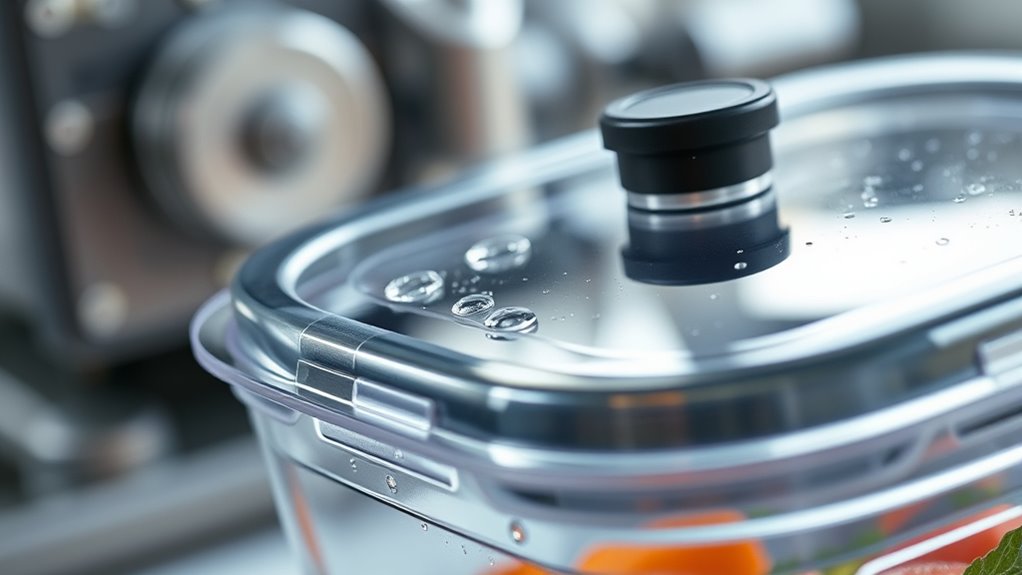
To effectively preserve freshness, advanced sealing and closure methods have become essential in modern delivery packaging. These techniques ensure that the product stays protected from air, moisture, and contaminants, extending its shelf life. You can use vacuum sealing to remove air and create an airtight environment, preventing spoilage. Heat-sealing with durable plastic films offers a secure closure that resists tampering. Innovative closures like resealable zippers or twist caps make it easy to reopen and reseal packages without compromising freshness. Understanding emotional support can also be beneficial when considering how to communicate about product quality with consumers, especially in cases of potential spoilage or quality issues.
Implementing Quality Control Measures During Packaging and Transit
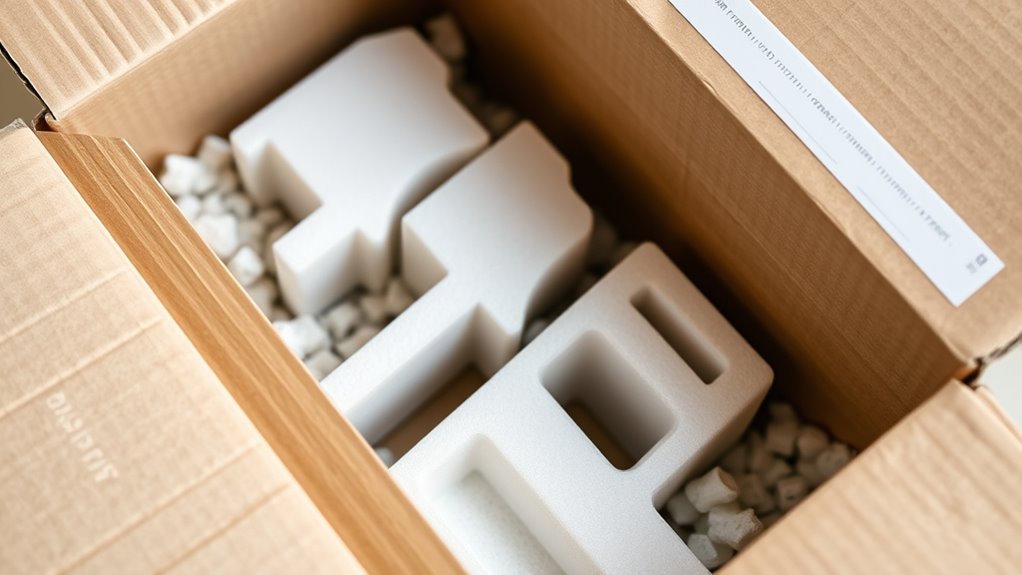
Ensuring quality control during packaging and transit is essential to maintain product integrity and customer satisfaction. You should implement clear procedures for inspecting each package before shipping, checking for proper sealing, labeling, and packaging integrity. Regularly train your staff on quality standards and handling protocols to prevent mistakes. Use standardized checklists to guarantee consistency and catch any issues early. Monitor transit conditions, like temperature and humidity, especially for sensitive items, and choose reliable carriers known for timely delivery. Track shipments and gather feedback to identify recurring problems. Additionally, utilizing tuning modifications can help ensure that products reach customers in optimal condition. By actively overseeing every step, you reduce the risk of damage or spoilage, guaranteeing your products arrive in excellent condition. Consistent quality control fosters trust and reinforces your reputation for delivering high-quality items.
Frequently Asked Questions
How Do Packaging Materials Affect Product Shelf Life?
You might wonder how packaging impacts your product’s freshness. Well, the right materials protect against moisture, oxygen, and light, all of which can degrade quality. By choosing proper packaging, you slow down spoilage, extend shelf life, and maintain flavor and texture. Active packaging, like vacuum-sealing or barrier films, further preserves your product. So, investing in quality packaging directly benefits your product’s longevity and customer satisfaction.
Can Innovative Insulation Be Reused or Recycled?
Innovative insulation can often be reused or recycled, depending on its materials. You should check the manufacturer’s guidelines for reuse options or recycling programs. Many modern insulations, like foam or biodegradable options, are designed with sustainability in mind, making it easier for you to reduce waste. By choosing recyclable or reusable insulation, you help minimize environmental impact while maintaining product quality during delivery.
What Are Cost-Effective Custom-Fit Packaging Options?
When choosing custom-fit packaging, you want options that balance cost and protection. You might consider foam or molded pulp inserts tailored to your products, which can often be reused or recycled. Corrugated boxes with precise die cuts also offer a cost-effective solution, ensuring your items stay secure without overspending. By prioritizing materials that are lightweight yet durable, you can save on shipping costs while maintaining product quality during delivery.
How Do Eco-Friendly Options Compare in Durability?
Sure, eco-friendly options might seem like the fragile flower of packaging, but don’t let that fool you. They’re surprisingly durable and designed to withstand the rigors of shipping. You get to save the planet while keeping your products safe—talk about a win-win. So, when comparing durability, eco-friendly materials often match or even outperform traditional options, proving that caring for Earth doesn’t mean sacrificing strength.
What Are the Best Practices for Tamper-Evident Packaging?
When choosing tamper-evident packaging, you should prioritize clarity and security. You’ll want to select options like seals, shrink bands, or breakable caps that clearly show if tampering occurs. Make sure your packaging is easy to inspect and difficult to modify without detection. Always test your packaging to ensure it maintains integrity during transit, and educate your staff on proper sealing techniques to maintain product safety and consumer trust.
Conclusion
Think of your packaging as the guardian of every product, much like a sturdy shield protecting a treasure. When you choose innovative insulation, eco-friendly materials, and secure seals, you guarantee your customers receive fresh, intact items every time. Just like a well-packed gift keeps surprises perfect until opened, your thoughtful packaging preserves quality and builds trust. Prioritize these practices, and you’ll turn every delivery into a reliable, memorable experience—protecting your reputation as surely as a fortress guards its treasures.
